Contents: 2024 | 2023 | 2022 | 2021 | 2020 | 2019 | 2018 | 2017 | 2016 | 2015 | 2014 | 2013 | 2012 | 2011 | 2010 | 2009 | 2008 | 2007 | 2006 | 2005 | 2004 | 2003 | 2002 | 2001
2008, 12
Hybrid local/global optical flow and spline multi-resolution analysis of myocardial motion in B-mode echocardiography images
language: English
received 18.11.2007, published 06.05.2008
Download article (PDF, 302 kb, ZIP), use browser command "Save Target As..."
To read this document you need Adobe Acrobat © Reader software, which is simple to use and available at no cost. Use version 4.0 or higher. You can download software from Adobe site (http://www.adobe.com/).
ABSTRACT
Since myocardial motion is directly related to cardiac vascular supply, it can be helpful in diagnosing the heart abnormalities. The most comprehensive and available imaging study of the cardiac function is B-Mode echocardiography. Diagnostic systems are expert dependent and motion is not clear in the B-mode echocardiography images and therefore many efforts are toward proposing new methods to measure the motion accurately. Most of the previous motion estimation methods suffer from shear, rotation and wide range of motions due to the complexity of the myocardial motion in B-Mode images. In order to increase the accuracy and robustness to shear, rotation and wide range of motions, a hybrid method based on a newly introduced algorithm called combined local global (CLG) optical flow in combination with multi-resolution spatiotemporal spline moments is proposed. The method achieves rotational error of 2.8 degrees per frame and amplitude error of 3.8 percent per frame. These results demonstrate a better efficiency with respect to other B-Mode echocardiography motion estimation techniques such as Lucas-Kanade, Horn-Schunck and spatiotemporal affine technique.
Key words: echocardiography, cardiac motion, combined local/global optical flow, spline multi-resolution, myocardial motion estimation, optical flow.
18 pages, 12 figures
Сitation: Nima Sahba, Vahid Tavakoli, Alireza Ahmadian, Mohammad D. Abolhassani, Mohammad Fotouhi. Hybrid local/global optical flow and spline multi-resolution analysis of myocardial motion in B-mode echocardiography images. Electronic Journal “Technical Acoustics”, http://www.ejta.org, 2008, 12.
REFERENCES
1. Leitman M. et al. Two-dimensional strain-novel software for real-time quantitative echocardiographic assessment of myocardial function. Journal of the American Society of Echocardiography, 2004, 17(2), 1021-1030.
2. Bohs L. N. et al. Speckle tracking for multidimensional flow estimation. Ultrasonics, 2000, 38(2), 369-375.
3. Abolhassani M. D., Norouzi A., Takavar A., Ghanaati H. Noninvasive temperature estimation using sonographic digital images. J. Ultrasound Med., 2007, 26(2), 215-222.
4. Alvarez L., Weickert J., Sanchez J. Reliable estimation of dense optical flow fields with large displacements. International Journal of Computer Vision, 2000, 39(1), 41-56.
5. Aubert G., Deriche R., Kornprobst P. Computing optical flow via variational techniques. SIAM Journal on Applied Mathematics, 1999, 60(1), 156-182.
6. Bigun J., Granlund G. H. Optical flow based on the inertia matrix in the frequency domain. In Proc. SSAB Symposium on Picture Processing, Lund, Sweden, 1988, 200-211.
7. Lamberti C. et al. Estimation of global parameters for the analysis of left ventricular motion. Presented at Computers in Cardiology, Rotterdam, The Netherlands, 2001, 429-432.
8. Bigun J., Granlund G. H., Wiklund J. Multidimensional orientation estimation with applications to texture analysis and optical flow. IEEE Transactions on Pattern Analysis and Machine Intelligence, 1991, 13(8), 775-790.
9. Black M. J., Anandan P. Robust dynamic motion estimation over time. In Proc. 1991 IEEE Computer Society Conference on Computer Vision and Pattern Recognition, IEEE Computer Society Press: Maui, HI, 1991, 292-302.
10. Nagel H.-H. Constraints for the estimation of displacement vector fields from image sequences. In Proc. Eighth International Joint Conference on Artificial Intelligence, vol. 2, Karlsruhe, West Germany, 1983, 945-951.
11. Bruhn A., Weickert J., Schnorr C. Combining the advantages of local and global optic flow methods. In Pattern Recognition of LNCS, Springer, 2002, 2444, 454-462.
12. Bruhn A., Weikert J, Schnorr C. Lucas-Kanade meets Horn and Schunk: combining local and global optic flow methods. Int. J. Comp. Vis., 2005, 61(3), 211-231.
13. Lin N., Papademetris X., Sinusas A. J., Duncan J. S. Analysis of left ventricular motion using a general robust point matching algorithm. In: Medical Image Computing and Computer-Assisted Intervention of LNCS, 2003, 1496, 556-563.
14. Weickert J., Schnorr C. A theoretical framework for convex regularizers in PDE-based computation of image motion. International Journal of Computer Vision, 2001, 45(3), 245-264.
15. Baraldi P. et al. Evaluation of differential optical flow techniques on Synthesized echo images. IEEE Transactions on Biomedical Engineering, 1996, 43(2), 259-272.
16. Lamberti C. et al. Topology of optical flowing 3D echocardiography. Presented at Computers in Cardiology, Lund, Sweden, 1997, 227-230.
17. Abolhassani A., Tavakoli V. Noninvasive thermal change detection in renal artery revascularization therapy. Submitted to Journal of Ultrasound in Medicine.
18. Suhling M., et al., Myocardial motion analysis from B-mode echocardiograms. IEEE Transaction on Image Processing, 2005, 14, 525-553.
19. Unser M. Splines: A perfect fit for signal and image processing. IEEE Signal Process. Mag., 1999, 16(6), 22-38.
20. Fleet D.J. and Jepson A.D. Computation of component image velocity from local phase information. International Journal of Computer Vision, 1990, 5(1), 77-104.
21. Galvin B., McCane B., Novins K., Mason D., Mills S. Recovering motion fields: An analysis of eight optical flow algorithms. In Proc. 1998 British Machine Vision Conference, Southampton, England, 1998.
22. Tavakoli V., Sahba N. et al. An evaluation of different optical flow techniques for myocardial motion analysis. IEEE proceeding on biomedical engineering, Kuala Lumpur, Malaysia, 2008.
23. Lucas B., Kanade T. An iterative image registration technique with an application to stereo vision. In Proc. Seventh International Joint Conference on Artificial Intelligence, Vancouver, Canada, 1981, 674-679.
24. Tavakoli V., Sahba N. et al. Adaptive multi-resolution myocardial motion analysis of B-Mode echocardiography images using Combined Local/Global optical flow. IEEE proceeding on Bioinformatics and Biomedical Engineering (iCBBE), Shanghai, China, 2008. (In press).
25. Bruhn A. Regularization in motion estimation. Master’s thesis, Department of Mathematics and Computer Science, University of Mannheim, Germany, 2001.
26. Weickert J., Schnorr C. Variational optic flow computation with a spatiotemporal smoothness constraint. Journal of Mathematical Imaging and Vision, 2001, 14(3), 245-255.
27. Tavakoli V., Ahmadian A. et al. A new optical flow technique for myocardial motion analysis based on affine concept in space and time. Submitted to IEEE transaction on medical imaging.
28. Tavakoli V., Sahba N. et al. An Optimized two-stage method for ultrasound breast image compression. IEEE proceeding on biomedical engineering, Kuala Lumpur, Malaysia, 2008.
29. Meunier J. et al. Assessing local myocardial deformation from speckle tracking in echography. SPIE Med. Imag., 1988, 20-29.
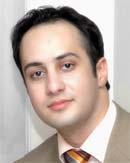 |
Nima Sahba received his B.S. and M.S. from University of Science and Research, Tehran, Iran (2001-2008). He is currently a research assistant at Research Center for Science and Technology in Medicine (RCSTIM), Tehran, Iran. His research interests are: Cardiovascular imaging, Mammography Mass Detection, Medical Image Compression and ranklets. е-mail: nimasahba(at)gmail.com |
|
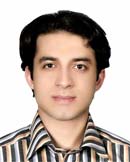 |
Vahid Tavakoli joined a joint degree program of M.S. Biomedical Engineernig and M.D. Medicine (Honored double degree) in 1998. He is currently working toward his PhD program in Electrical and Computer Engineering department, University of Louisville, KY, USA. His research interests are: Cardiovascular Motion Detection, Medical Robot Vision, Image-Guided surgery, Optical Flow and Registration. He is a student member of IEEE and IOMP and IMC. е-mail: vtavakoli(at)razi.tums.ac.ir |
|
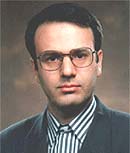 |
Alireza Ahmadian received his PhD and DIC in Biomedical Image Processing from Imperial College of Science, Technology in Medicine, Biomedical Systems Group, London 1997. He then carried out a postdoctoral position at Kings College London, Multimedia Lab for two years working on 3D medical image compression and transmission. He is currently an Associate Professor at Tehran University of Medical Sciences, Dept. of Biomedical Systems and research director of Research Centre for Science and Technology in Medicine, RCSTIM. His research interests are: multi-resolution wavelet analysis of biomedical signals and images, analysis of ECG signals, medical image segmentation, medical image compression. He is also a senior member of IEEE. е-mail: ahmadian(at)sina.tums.ac.ir |
|
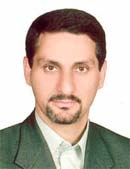 |
Mohammad D. Abolhassani was born in Tehran, Iran in 1965. He received his BSc in Electrical & Electronic Engineering from University College London, UK in 1989 and MSc in Digital Electronics & Communication from UMIST, Manchester, UK in 1990 and PhD in Biomedical Systems from Imperial College of Technology and Medicine, UK in 1994. Currently he is associate professor of Medical Physics and Biomedical Engineering Department of Tehran University of Medical Sciences and deputy head of Research Centre for Science and Technology in Medicine (RCSTIM). His research interests are medical instrumentation, medical ultrasound instrumentation, biological signal processing, and otoacoustic emission systems. | |
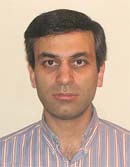 |
Mohammad Fotouhi received his M.D. diploma from Tehran University of Medical Science, Tehran, Iran (1991-1999). He then carried out cardiology program in Tehran Heart Center, Tehran, Iran (2001-2005). Currently he is working toward his fellowship program (interventional cardiology) in the same center. His research interests are: Electrophysiologic studies, Echocardiography and applying engineering methods in Echocardiography images. е-mail: m_fotuhi(at)yahoo.com |
|
